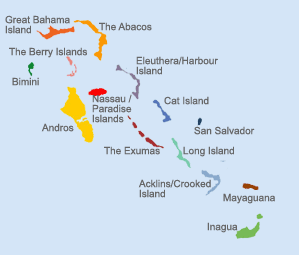 The Bahamas is an archipelago of some 700 hundred islands and 2,400 cays, rocks and islets starting approximately 50 miles off the coast of South Florida and stretching in a southeasterly direction over more than 100,000 square miles of open ocean. Though frequently referred to as being in the Caribbean because of its warm weather and breezy island life, its 5,358 square miles of land mass is technically north of the Caribbean.
The Bahamas is an archipelago of some 700 hundred islands and 2,400 cays, rocks and islets starting approximately 50 miles off the coast of South Florida and stretching in a southeasterly direction over more than 100,000 square miles of open ocean. Though frequently referred to as being in the Caribbean because of its warm weather and breezy island life, its 5,358 square miles of land mass is technically north of the Caribbean.
The estimated population of 353,658 persons lives within 14 major islands and cays. The capital city being Nassau, located on the island of New Providence. The country’s official language is English and the official religion is Christianity.
The Arawak Indians were the original inhabitants of The Bahamas migrating through the Antilles from South America. A few decades after Columbus landed on San Salvador in 1492, which he named Baja Mar for its shallow seas, the Spanish had depopulated the islands by shipping the peaceful Arawaks into slavery in the mines of Hispaniola and Cuba, where they died by the thousands.
The Bahamas remained mostly unpopulated until a group of English settlers from Bermuda called the Company of Eleutheran Adventurers, established the first permanent settlement in The Bahamas. Considered religious refugees, in 1647 they organized a community on what is now called the island of Eleuthera which means freedom.
During the late 17th and early 18th centuries, piracy flourished in the islands because of their proximity to important shipping routes. The power of the buccaneers and notorious privateers including Sir Francis Drake, Henry Morgan and Blackbeard, was crushed by Woodes Rogers, the first Royal Governor, who established orderly conduct in 1718. As he expelled piracy, and restored commerce on the island, ordaining the motto Expulsis Piratis – Resituta Commercia.
This gave way to an influx of settlers after the American war of Independence, when some 6,000 American loyalists and their slaves settled in The Bahamas.
The American Civil War brought prosperity to The Bahamas, which served as a transfer point for munitions and medical supplies to be run through the northern blockade of Confederate ports. Cotton from the south was a short lived commodity of exchange.
The Bahamas prospered again however, during the 20th century prohibition era in the United States, mostly because of its proximity to the mainland. During this time there was enormous economic prosperity as the islands supplied liquor for American rumrunners.
Ideal weather conditions were advantageous for the Royal Air Force as they used The Bahamas as a flight training area during World War II.
In the post-war years, The Bahamas has become one of the world’s most coveted vacation destinations. In 1950, an estimated 40,000 visitors vacationed in The Bahamas. This would mark the beginning of a new industry that would experience unparalleled growth and development.
The Bahamas celebrated the arrival of its five millionth visitor in 2010 for the second time in the country’s history. This represents approximately 1.5 million cruise visitors and 3.5 million stopover visitors. According to the Ministry of Tourism, 60% of the gross domestic product is derived from tourist related efforts which accounts for an injection of just over $2 billion into the economy.
The financial services sector constitutes the second pillar of the Bahamian economy providing 20 per cent of GDP. The Bahamas boasts an attractive environment for both individuals and companies seeking to conduct business and is home to a considerable number of banking institutions, mutual funds, insurance companies and International Business Companies.
The Bahamas achieved independence from Britain July 10, 1973, and has a continued legacy of Parliamentary democracy for over 300 years. The Bahamas is proud to be a fully self-governing member of the Commonwealth and a member of the United Nations, the Caribbean Community (CARICOM) and the Organization of American States (OAS).
